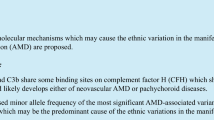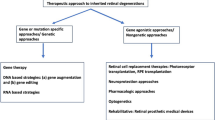Abstract
Purpose
Posterior column ataxia and retinitis pigmentosa (PCARP) is a rare form of syndromic RP associated with mutations in the FLVCR1 gene. Recent evidence has suggested a spectrum in the phenotype depending on the genotype.
Methods
Six individuals with retinitis pigmentosa (RP) carrying mutations in the FLVCR1 gene underwent detailed ophthalmological examinations at the Center for Ophthalmology and two of these also an extensive neurological examination at the Department of Neurology in Tuebingen, Germany.
Results
The mutation spectrum in our cohort comprised one nonsense mutation, one 1-bp deletion, two missense variants, and one splice site variant (c.1092+5G>A). Three patients presented with a typical clinical picture of autosomal recessive RP, two patients presented with atypical RP, and one patient presented with a particularly mild form of RP. The findings of the patients that underwent detailed neurological and neurophysiological testing were not suggestive for the presence of progressive PCA, but one patient showed mild cerebellar signs without worsening over time. Five out of six of our cases carry the splice site variant c.1092+5G>A at least on one allele possibly providing evidence as to that this splice site variant may cause a milder form of non-syndromic autosomal recessive RP.
Conclusions
Mutations in FLVCR1 can present with the clinical picture of a non-syndromic autosomal recessive RP (in this case RP without PCA), RP with mild cerebellar signs, but also PCARP. Additionally, we show evidence for a spectrum of the severity of the retinal involvement likely depending on the genotype.


Similar content being viewed by others
References
Parmeggiani F (2011) Clinics, epidemiology and genetics of retinitis pigmentosa. Curr Genomics 12:236–237. https://doi.org/10.2174/138920211795860080
Zobor D, Zrenner E (2012) Retinitis pigmentosa - a review. Pathogenesis, guidelines for diagnostics and perspectives. Ophthalmologe 109:501–514;quiz 515. https://doi.org/10.1007/s00347-012-2555-6
Liew G, Michaelides M, Bunce C (2014) A comparison of the causes of blindness certifications in England and Wales in working age adults (16-64 years), 1999-2000 with 2009-2010. BMJ Open 4:e004015. https://doi.org/10.1136/bmjopen-2013-004015
Hartong DT, Berson EL, Dryja TP (2006) Retinitis pigmentosa. Lancet 368:1795–1809. https://doi.org/10.1016/S0140-6736(06)69740-7
Higgins JJ, Morton DH, Patronas N, Nee LE (1997) An autosomal recessive disorder with posterior column ataxia and retinitis pigmentosa. Neurology 49:1717–1720
Rajadhyaksha AM, Elemento O, Puffenberger EG et al (2010) Mutations in FLVCR1 cause posterior column ataxia and retinitis pigmentosa. Am J Hum Genet 87:643–654. https://doi.org/10.1016/j.ajhg.2010.10.013
Puffenberger EG, Jinks RN, Sougnez C et al (2012) Genetic mapping and exome sequencing identify variants associated with five novel diseases. PLoS One 7:e28936. https://doi.org/10.1371/journal.pone.0028936
Ishiura H, Fukuda Y, Mitsui J et al (2011) Posterior column ataxia with retinitis pigmentosa in a Japanese family with a novel mutation in FLVCR1. Neurogenetics 12:117–121. https://doi.org/10.1007/s10048-010-0271-4
Shaibani A, Wong L-J, Wei Zhang V et al (2015) Autosomal recessive posterior column ataxia with retinitis pigmentosa caused by novel mutations in the FLVCR1 gene. Int J Neurosci 125:43–49. https://doi.org/10.3109/00207454.2014.904858
Quigley JG, Yang Z, Worthington MT et al (2004) Identification of a human heme exporter that is essential for erythropoiesis. Cell 118:757–766. https://doi.org/10.1016/j.cell.2004.08.014
Chiabrando D, Castori M, di Rocco M et al (2016) Mutations in the heme exporter FLVCR1 cause sensory neurodegeneration with loss of pain perception. PLoS Genet 12:e1006461. https://doi.org/10.1371/journal.pgen.1006461
Tiwari A, Bahr A, Bähr L et al (2016) Next generation sequencing based identification of disease-associated mutations in Swiss patients with retinal dystrophies. Sci Rep 6:28755. https://doi.org/10.1038/srep28755
Yusuf IH, Shanks ME, Clouston P, MacLaren RE (2018) A splice-site variant in FLVCR1 produces retinitis pigmentosa without posterior column ataxia. Ophthalmic Genet 39:263–267. https://doi.org/10.1080/13816810.2017.1408848
Told R, Baratsits M, Garhöfer G, Schmetterer L (2013) Early treatment diabetic retinopathy study (ETDRS) visual acuity. Ophthalmologe 110:960–965. https://doi.org/10.1007/s00347-013-2813-2
Melamud A, Hagstrom S, Traboulsi E (2004) Color vision testing. Ophthalmic Genet 25:159–187. https://doi.org/10.1080/13816810490498341
Schiefer U, Pätzold J, Dannheim F (2005) Conventional perimetry I: introduction--basics. Ophthalmologe 102:627–644; quiz 645–6. https://doi.org/10.1007/s00347-005-1189-3
Schiefer U, Pätzold J, Dannheim F (2005) Conventional techniques of visual field examination part 2: confrontation visual field testing -- kinetic perimetry. Ophthalmologe 102:821–827; quiz 828-9. https://doi.org/10.1007/s00347-005-1212-8
Marmor MF, Fulton AB, Holder GE et al (2009) ISCEV standard for full-field clinical electroretinography (2008 update). Doc Ophthalmol 118:69–77. https://doi.org/10.1007/s10633-008-9155-4
Hood DC, Bach M, Brigell M et al (2012) ISCEV standard for clinical multifocal electroretinography (mfERG) (2011 edition). Doc Ophthalmol 124:1–13. https://doi.org/10.1007/s10633-011-9296-8
Glöckle N, Kohl S, Mohr J et al (2014) Panel-based next generation sequencing as a reliable and efficient technique to detect mutations in unselected patients with retinal dystrophies. Eur J Hum Genet 22:99–104. https://doi.org/10.1038/ejhg.2013.72
Weisschuh N, Mayer AK, Strom TM et al (2016) Mutation detection in patients with retinal dystrophies using targeted next generation sequencing. PLoS One 11:e0145951. https://doi.org/10.1371/journal.pone.0145951
Schmitz-Hübsch T, du Montcel ST, Baliko L et al (2006) Scale for the assessment and rating of ataxia: development of a new clinical scale. Neurology 66:1717–1720. https://doi.org/10.1212/01.wnl.0000219042.60538.92
Brown JK, Fung C, Tailor CS (2006) Comprehensive mapping of receptor-functioning domains in feline leukemia virus subgroup C receptor FLVCR1. J Virol 80:1742–1751. https://doi.org/10.1128/JVI.80.4.1742-1751.2006
Liu X, Xiao J, Huang H et al (2015) Molecular genetic testing in clinical diagnostic assessments that demonstrate correlations in patients with autosomal recessive inherited retinal dystrophy. JAMA Ophthalmol 133:427–436. https://doi.org/10.1001/jamaophthalmol.2014.5831
Adackapara CA, Sunness JS, Dibernardo CW et al (2008) Prevalence of cystoid macular edema and stability in oct retinal thickness in eyes with retinitis pigmentosa during a 48-week lutein trial. Retina 28:103–110. https://doi.org/10.1097/IAE.0b013e31809862aa
Hajali M, Fishman GA (2009) The prevalence of cystoid macular oedema on optical coherence tomography in retinitis pigmentosa patients without cystic changes on fundus examination. Eye 23:915–919. https://doi.org/10.1038/eye.2008.110
Funding
This study was supported by the Tistou and Charlotte Kerstan foundation.
Author information
Authors and Affiliations
Corresponding author
Ethics declarations
Conflict of interest
The authors declare that they have no conflict of interest.
Ethical approval
All procedures performed in studies involving human participants were in accordance with the ethical standards of the institutional and/or national research committee and with the 1964 Helsinki declaration and its later amendments or comparable ethical standards.
Informed consent
Informed consent was obtained from all individual participants included in the study.
Additional information
Publisher’s Note
Springer Nature remains neutral with regard to jurisdictional claims in published maps and institutional affiliations.
The paper has been presented as a poster at the EURETINA 2018 Congress, September 20–23, in Vienna, Austria.
Rights and permissions
About this article
Cite this article
Kuehlewein, L., Schöls, L., Llavona, P. et al. Phenotypic spectrum of autosomal recessive retinitis pigmentosa without posterior column ataxia caused by mutations in the FLVCR1 gene. Graefes Arch Clin Exp Ophthalmol 257, 629–638 (2019). https://doi.org/10.1007/s00417-018-04233-7
Received:
Revised:
Accepted:
Published:
Issue Date:
DOI: https://doi.org/10.1007/s00417-018-04233-7




